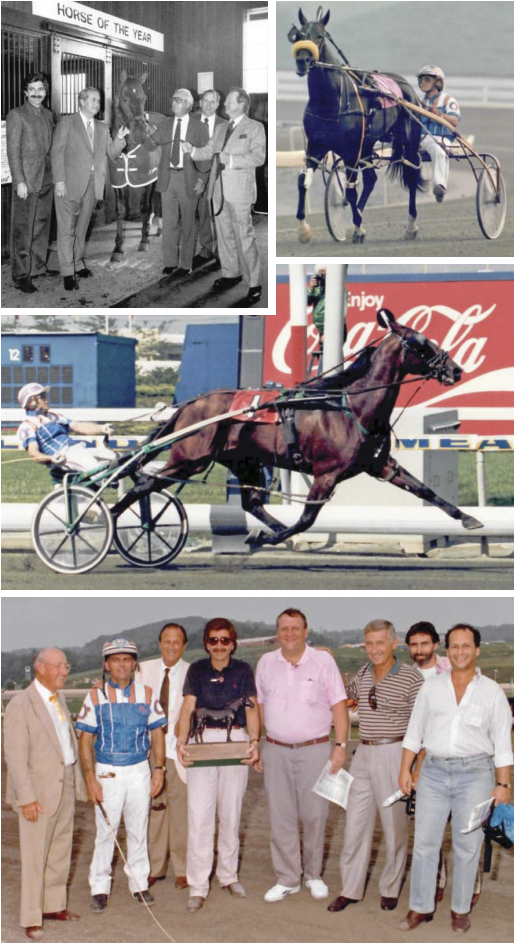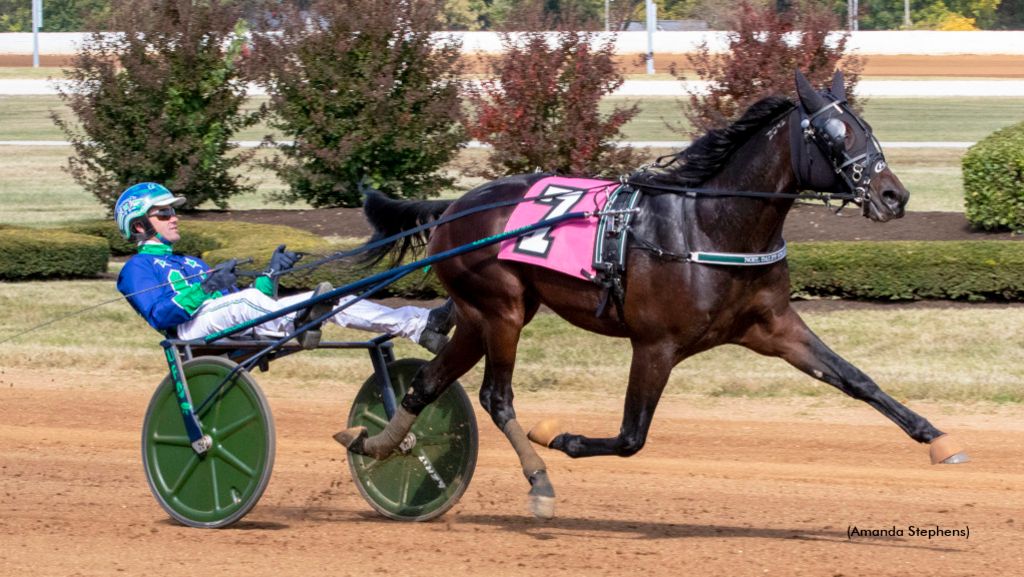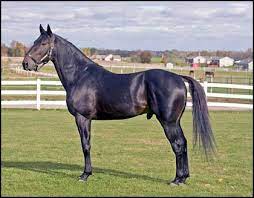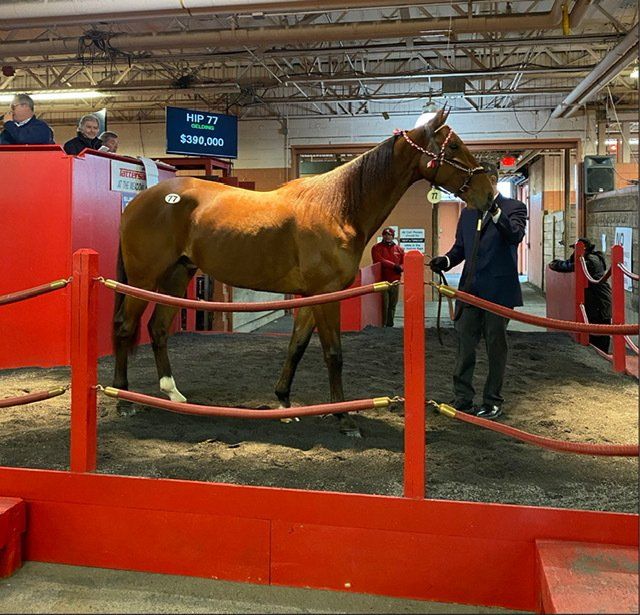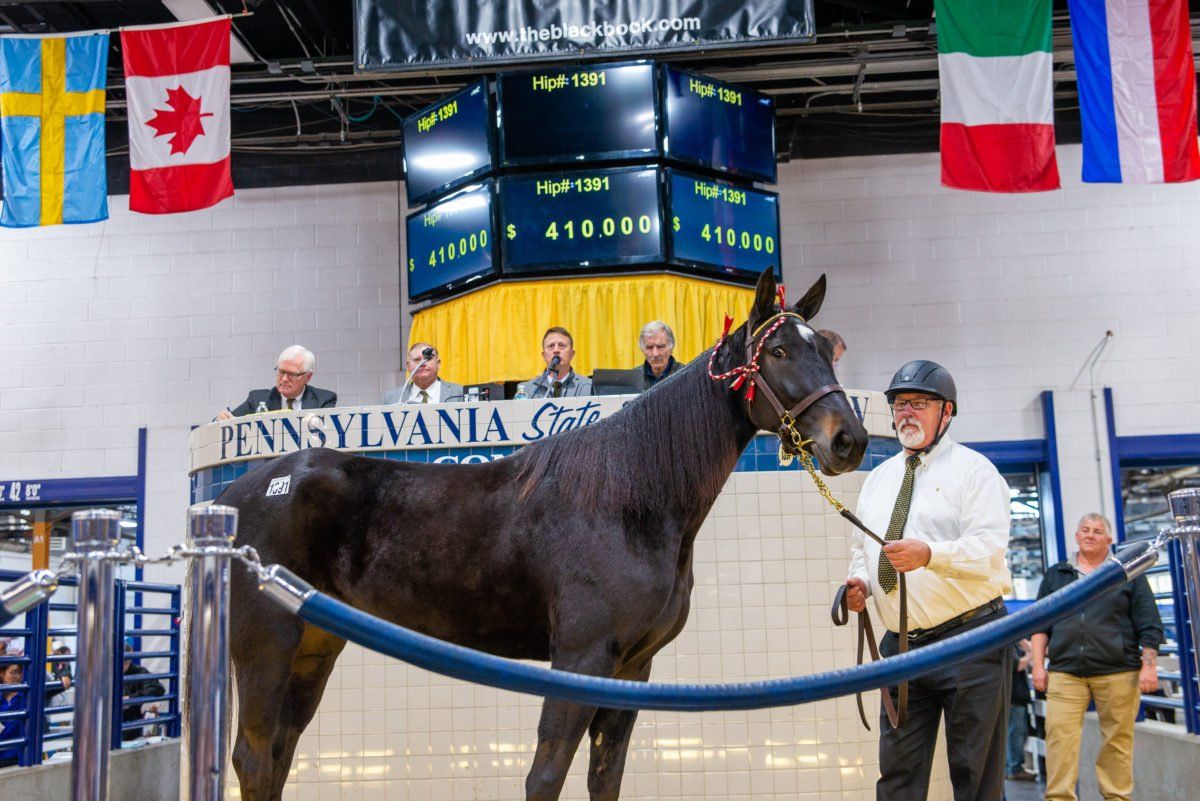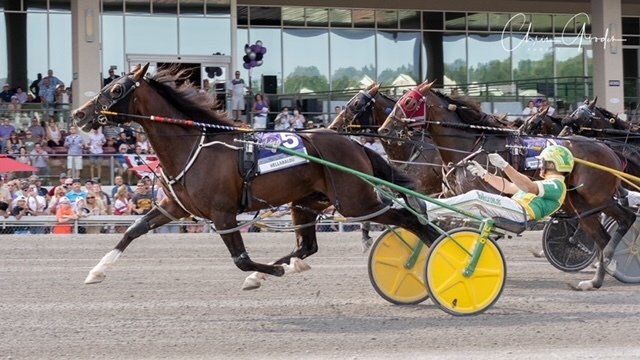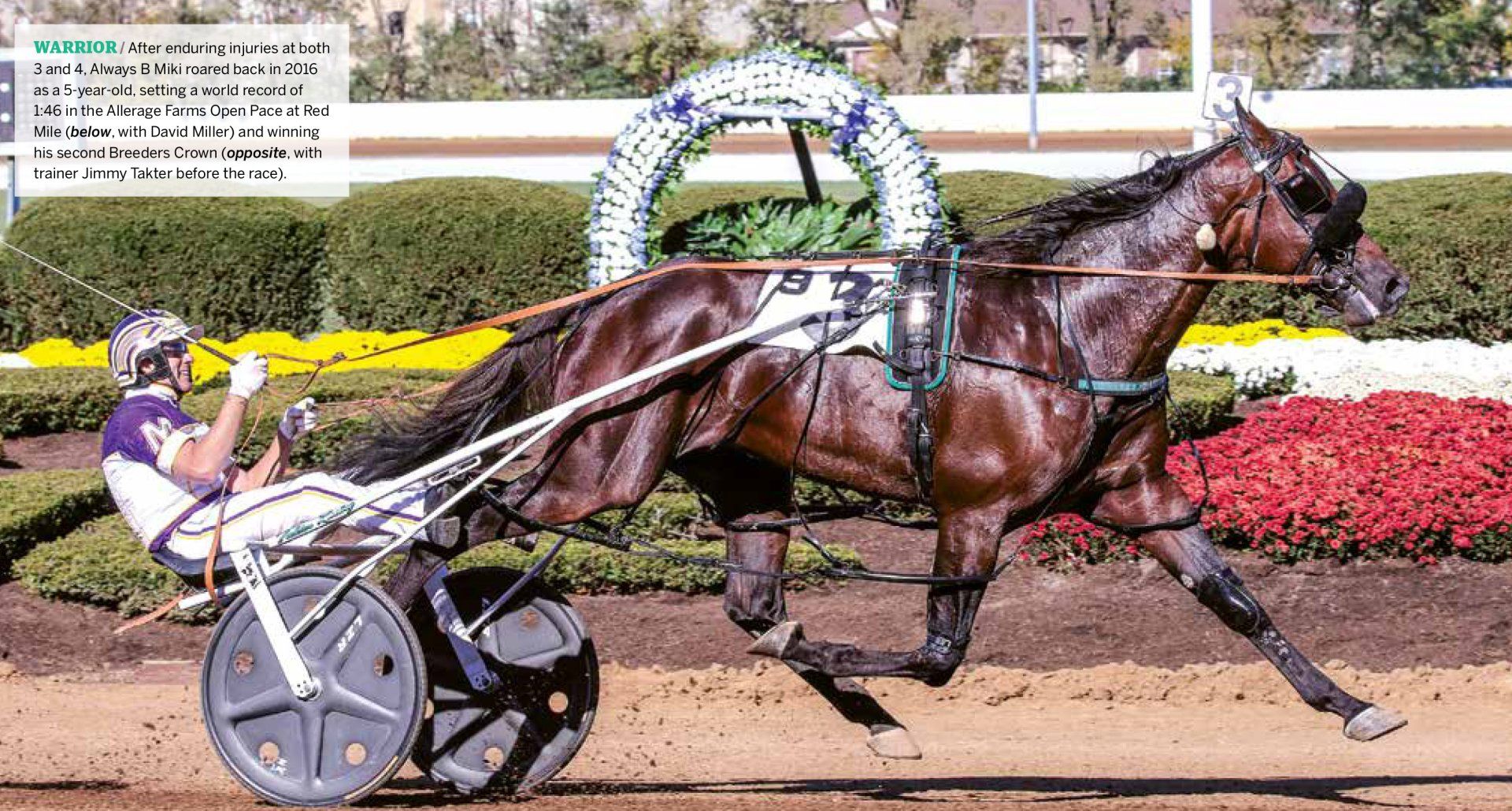Boni's Trifecta
Nihilator, Camtastic, Always B Miki
Many have won more Breeders Crown races, but only a couple of owners have won Crowns 30 years apart. One of them is Bob Boni, who in 1985 owned an interest in Nihilator, who captured the Crown for 3-year-old colt pacers. Last year Boni was standing in the winner’s circle at Woodbine after Always B Miki, who he co-owns as a member of Bluewood Stable, won the Crown Older Pace. In between, Boni shared ownership of Camtastic, a Crown winner in 1987 and ’88.
If you enjoy talking horses, Boni’s your guy. By taking a job right out of high school with Pine Hollow Stud, Boni is almost a 50-year veteran of the sport. Raised in Queens, N.Y., his parents took him to Yonkers Raceway and he became a fan of harness racing.
After working at Pine Hollow, Boni operated International Standardbred Agency, beginning work as a bloodstock agent, which he continues today as Northwood Bloodstock. In between the tenures of those agencies he managed racing partnerships (such as Nihilator’s ownership group, Wall Street Stable) and the combined racing-breeding venture of Dreamaire. He also served as president and general manager of the North American Sale at Garden State Park, with that experience now putto work managing the Goshen Yearling Sale.
In addition to his bloodstock and sales company work, and in 2016 following Always B Miki around from track to track—he didn’t miss a race—Boni also serves as a director of the Standardbred Breeders and Owners Association of New Jersey and is a trustee of the Harness Racing Museum and Hall of Fame.
From top: (from left) Boni, Lou Guida, Billy Haughton, Albert Adams and Jack Baugh welcomed Nihilator to Almahurst Farms,
where he began his stallion career in 1986.
Bill O’Donnell and Camtastic on the track for the 1988 Adios final. Nihilator and catchdriver O’Donnell at the Meadowlands in 1985.
Boni holds Camtastic’s Adios trophy, joined by Delvin Miller, O’Donnell, St. Louis Cardinals Hall of Famer Stan Musial, Bob Bencal,
What do you remember most about your start in racing?
One of the things that I’m most proud of is winning Breeders Crowns 30 years apart. Nihilator (winner of the 1985 Breeders Crown 3-Year-Old Colt Pace) we purchased as a yearling early; Camtastic (winner of the 1987 Crown 2-Year-Old Colt Pace and ‘88 Crown 3-Year-Old Colt Pace) was a homebred; and Always B Miki (winner of the 2015 and 2016 Crown Older Pace) was purchased in training.
My first brush with great horses came when I went to work for Pine Hollow Stud in 1969. It was a great education because we boarded 600 head of horses during some periods of time. And the horses weren’t numbers to me. I knew Tiffy Time, and Noreen Napoleon, and Speedy Rodney and Romeo Hanover.
Then in 1982-83 I was a part of Dreamaire Stable and we raced Tanzy Lobell, Time O Nic, Lushkara, Madam Madusa those mares were world champions. Dreamaire owned 20 mares and five of them had records of 1:55 or faster. The significance of that is there were only 20 mares in existence with marks of 1:55 or faster, and no one else owned more than two. And we had another three mares in 1:55.1.
I always liked mares that performed. The mission was to breed, and when you’re trying to breed, if you can have that one more extra quality of good performance, it seems to carry on. That’s what motivated us to buy those mares. You could buy lots of yearlings and never come up with the mares we bought. Lushkara was the crown jewel of that group of mares because she produced Camtastic.
How did you become an owner of Nihilator?
I had been very active trying to buy mares in foal to Niatross. Through Lou’s (Guida) assistance, I had any info I wanted about Niatross. In those days, there was no Pathway. I was trying to buy Margie’s Melody so I developed a relationship with Bob Gangloff, the owner of the mare and the breeder of Nihilator.
Unbeknownst to most people, Hempt came very close to buying Margie’s Melody in foal, carrying Nihilator. And she carried 12 months for him!
I always remember something Delvin (Miller) said about Niatross, that it was like the horse skipped a generation. Remember, when he went 1:49.1, the record was still 1:52. And I felt the same way. I don’t think we’ve seen a jump in generations like this again. Maybe the closest to it is Muscle Hill.
When the Niatross foals were born, I asked Lou to get me a list. His first crop was about 148-150 and it was pretty much split 50-50 colts and fillies. I noticed a lot of the foals were owned by small breeders. I’m starting to get an idea that if you could own 10 percent of Niatross’ colts, it might be big.
I remember exactly when and where I was when I came up with this. It was a dreary Saturday morning, I was in the city (New York) and walking to Bloomingdale’s when it dawned on me. I can tell you exactly where the pay phone was, and I called Lou. Lou was a great idea guy. He loved anything new. He said, ‘Great! Let’s do it.’
Since Niatross stood his first season at Castleton, Castleton owned a fair number of colts, but I didn’t like the mares. So I
traveled around to look at the colts. I went to Blue Chip because they had three colts there and I liked Pershing Square. He was a nice, plain, correct bay colt with a good pedigree. The only surprise with him came later when we found out he was ridgling.
When we first bought the colts, we didn’t have a plan. We thought of putting them in a sale. But that quickly changed to ‘Let’s
race them.’ And so we put together Wall Street Stable and we got the financing because Lou had a very friendly banker. We paid $825,000 for seven colts. In addition to Nihilator the group included Pershing Square, Flight Of Fire, Cruncher and Port Stanley.
Nihilator was the last one of the group that we bought, and the cheapest. I said we’d pay $100,000, and he (Gangloff) said $105,000. So I flew out to Indiana and Gangloff picked me up at the airport and we drove out to his farm. There was snow on the ground. It’s February or March and Nihilator is an early yearling. I asked him to kick him out in the paddock, but he had cows in the paddock that day, they alternated with the horses, so that didn’t happen.
Nihilator was very much like Niatross, but it was like you took a piece of sandpaper and smoothed the rough edges off. Now Gangloff wants $125,000, and I want to pay $100,000.
I flew home and the next day we Federal Expressed him a check for $100,000, with a return Fed Ex envelope if he didn’t want to sell the colt. He called the next day and asked if we could wire the money instead. I later found out he wanted money for his business.
Subsequently, when Nihilator won the Woodrow Wilson we bought the dam and granddam of Nihilator for $750,000, plus a
breeding to Nihilator. Then we sold Margie’s Melody for $750,000. She had the one we wanted, and she was never going to have another Nihilator. We sold her in foal to John Signorelli’s Saratoga Standardbreds.
It turned out she was carrying twins and aborted and became a problem breeder.
Nihilator was raised by Schare Adams at Standardbred Pacers & Trotters in Lexington. We decided who would get the horses and Billy Haughton got Nihilator.
He went into training with Haughton and the first call I got from Billy, he says, ‘Do you mind if we freeze his splints?’ He had two big splints so I was thinking, here we are freezing splints in December. That was probably the last significant vet work he had until he had quarter cracks as a 2 year old.
The quarter cracks were only a problem early in his 2-year-old season. Right away, Billy wanted to try the piano wire, which
was a new thing, and he was going to try to do it himself. And Ernie (Gaskin, a Haughton assistant trainer) said, ‘Let’s just send him to the University of Pennsylvania.’ So they sent him over there. He wore a window bar shoe, and where the quarter crack was, there was no shoe. Instead of the patches used today, they literally wove piano wire, like a shoelace, to close up the crack. Then on the night of the (Woodrow) Wilson eliminations, he had a quarter crack on another foot. But by the end of his 2-year-old season, it was never an issue again. After the splints and the quarter cracks, I think his hocks were only injected once.
The first time I saw him train I thought he looked like a quality colt. And the faster he went, the better he went.
I’m a big believer in fate. The first day they put Nihilator and Pershing Square in to baby race, Billy (Haughton) gave Tommy (Haughton) his choice of who to drive, and Tommy picked Pershing Square. As far as how Billy O’Donnell came to drive Nihilator, first of all, the fact that in 1984 O’Donnell, who was a leading driver at the Meadowlands, would not have a mount in the Woodrow Wilson, that was fate.
Billy (Haughton) decided on his own to take himself off of Nihilator. It was 100 percent his decision. I remember getting a panicked call from Lou. He wanted to know what to say to Haughton. I said to tell him thank you, and he would still get his five percent (driver commission).
What do you consider to be Nihilator’s greatest race?
His race as a 2 year old the first week of the Grand Circuit in Lexington. (Ni- hilator beat Niafirst despite starting from post 12, in the second tier, and being parked until he pulled away in the stretch drive, delivering a :27.3 final quarter to win by 2 1⁄2 lengths, with Marauder third.) That race separated him. He wasn’t just fast, he wasn’t just good. He was parked the mile and in the stretch he just drew off. It stunned me.
Nihilator was part of one of harness racing’s most sensational races of all time, the Breeders Crown at The Meadows, which was won by Dragon’s Lair, the hometown horse. Why did Nihilator get beat?
He didn’t race the second week in Lexington, then he went to The Meadows and won the first heat of the Breeders Crown, but he wasn’t good. He just got beat. Later, Guida went out and bought Dragon’s Lair. But the two horses never met again.
As a 3 year old, Nihilator suffered another defeat—while in the midst of an undefeated season—in the Adios at The Meadows. What happened that time?
Originally, we were never going to the Adios because the plan was to go from the Meadowlands to Springfield and time trial there. Nihilator won at the Meadowlands on Hambletonian day in 1:49.3 while On The Road Again won the U.S. Pacing Championship in 1:51.4 that same day. After the races we were sitting with Delvin (Miller, who founded The Meadows and created the Adios and maintained close ties with the track). Del Miller is asking us if we’ll bring our horse to the Adios. How can we say no?
In the first heat of the Adios, Nihilator had the rail and got away seventh, and 15 years later O’Donnell admitted over
lunch, ‘Boy, did I drive bad.’ (Nihilator finished fourth after being parked out by winner Marauder.) He won the second heat and we scratched from the race-off. And the funny part was two years later, when Camtastic won the Adios, we’re standing there with the trophy and O’Donnell says something like, ‘I didn’t know there was a trophy with this race.’
In Springfield it rained. Then DuQuoin came and his feet were bothering him. He was much better gaited, and much faster, with the aluminums, but they took their toll.
There were no trackside indicators at Du Quoin, so it’s hysterical to think what happened. Ernie Gaskin was standing at the half, up on a little hill, with a bull-horn, yelling the times. O’Donnell laughs about how all he heard was a blur of noise as he went by. The funniest line of the day was Haughton wrote down all the splits on a piece of white paper—quarter, three-eighths, half, five-eighths, three-quarter pole. And when Nihilator comes up short (he hit the wire in 1:50.4, far short of his sire’s mark of 1:49.1),O’Donnell and Haughton are looking at each other and O’Donnell says, ‘One problem, Bill. You forgot to put down the final time.’ He’s about the only guy who could get away with saying that.
After that, the pressure was off. Nihilator went to Garden State Park and won the Dancer—that’s when Freehold was
closed because of the fire. In the winner’s circle, Haughton and I asked O’Donnell, ‘You think he’d be OK on a half?’
O’Donnell said he’d have no problems. So I turned to Guida and told him we were going to Delaware.
Initially, we weren’t planning to go to Delaware. Leon Caston, who took care of Pershing Square, thought he would have his moment in Delaware, and then the truck pulls in with Nihilator. In order to be comfortable, at 7 a.m. on Monday morning, after Haughton had his Bob Evans breakfast, he buzzed Nihilator, going into the first turn there as fast as he could go. There was a big crowd and most
of them left convinced Nihilator wouldn’t have any problems. At the draw, the first pill that came out was Nihilator, then post one.
But the Jug was a tough race for him. The only time I’ve seen a horse tired was
after the Jug. I went back to the barn afterwards and he almost had his eyes closed. If we needed to race a third heat, I’m not sure he would have won. (Nihilator won the Jug with heat victo ries in 1:53.1 and 1:52.1, and in the second heat he won by a mere head over stable mate Pershing Square, with Dignatarian a neck back in third. O’Donnell and Nihila tor started from post one in the second heat and Nihilator raced with a horse on his flank or at his neck the entire race.) After the Jug, Nihilator went to Lex ington and he raced another two heats, so he raced four heats in two weeks. Part of the Nihilator experience was having a horse with Billy Haughton and being around him. How he related to people, from grooms to his biggest own ers, was unbelievable. He could sit in a track kitchen with a groom to his left, the billionaire Lloyd Lloyds across from him, and some harness racing dignitary and make everyone comfortable. And the big moment didn’t faze him, and he was not afraid to make changes, to do something different.
So two years after Nihilator is retired to stud duty, Camtastic comes along.
The thing I’ll always remember about Camtastic is early on, when Bob (Bencal) was jogging him, obviously second to the colt showing talent, Bob said the horse would stay on the track all day and he would be just as happy. The horse was happy being on the track. He always showed he wanted to do it. And for a guy who was labeled a conservative trainer, Camtastic didn’t get to Florida until mid December—because he was in partner ship we were selling out and the attorneys advised us not to do anything until it was done—and still the colt made his first start on May 29 in a baby race. He was ready in 3 ½ months!
Camtastic won a lot of races relatively easily. As for his best race, the one that comes to mind is when he set the two-heat world record (in Lexington). In both races he was dead game. He did all the work and was dead game and unbelievably tough. He hung on by a nose. The rest of the year he was untouchable. Before Lexington, he didn’t win the Woodrow Wilson at the Meadowlands.
He won an elim, but that year there was a week off between the eliminations and the final. O’Donnell wanted to qualify him, maybe Monday. But before that, I went to the barn late after the races, and he wasn’t throwing his head. He would not have been a good horse in detention barns because he would always throw his head. So I saw he wasn’t throwing his head and all I said to Bencal was,
‘What’s wrong?’ The colt had a temperature. Camtastic was owned by a limited partnership and I had made 170 reservations in the dining room. Some people thought we scratched so our other horse Threefold would have a better chance to win, but we scratched early enough to let another horse in the race. Even Odds ended up winning.
(Camtastic finished off his freshman season by capturing the Breeders Crown by 5 3⁄4 lengths—his 13th victory in 14 starts—and was voted the 1987 Two-Year-Old Colt Pacer of the Year and Pacer of the Year.)
So as a 3 year old Camtastic earned $1.1 million and won 16 of 22 starts, but it wasn’t a smooth season.
O’Donnell trained him in Florida during the winter and didn’t like how he trained, and when the season got started he didn’t have confidence in the horse. He didn’t do any good in the North America Cup, but he won his Meadowlands Pace
elim (by 6 1⁄2 lengths). He won the first heat of the Jug. He won races in Lexington.
At the Breeders Crown, O’Donnell was insistent after the elim that the horse’s hocks needed done. Bencal says the horse
is fine. So I get to the track the next week for the final and I see Cindy Mikita (the colt’s caretaker) and I tell her that if
O’Donnell asks if we did his hocks, tell him yes, even though we didn’t. O’Donnell goes the last trip and brings him back and says, ‘He’s good. But he was running out a little bit in the stretch; he’s probably just needle sore from where they did his hocks.’ The horse won the final and he dominated.
Then he had a good 4-year-old season. He beat everyone he faced, but he had to race Matt’s Scooter, who was a great horse.
Twenty-five years after you raced Camtastic, you buy an interest in Always B Miki. What has this experience been like?
Like my other top horses, so many people were wrapped up with this horse, and that makes it special.
Always B Miki became the sport’s fastest horse, what was his best race?
The Ewart first, and then the Breeders Crown. The Ewart because first-over to Wiggle It Jiggle It. To go :26 up the backside, and you’re parked by Wiggle It Jiggleit, as he was, you’ve got to give the edge to the Ewart. Then the Breeders Crown.
When horses win races that they’re not supposed to win, that makes it more remarkable. Late in the stretch, I had him losing the race.
His 3-year-old season was remarkable too. The Meadowlands Pace (when he was parked three wide the entire mile and finished second in1:46.4) was significant, but we saw that he wasn’t a fluke because he went to being the best 3 year old. He won both weeks in Lexington and then went and won the Monument Circle at Hoosier Park. All the big ones were in it and he dominated on a really miserable night. He paced in 1:52 and that same night Bettor’s Edge and Sweet Lou finished on the wire together (a neck apart) in 1:53. That race made me realize he was
more than just a very good horse.
Miki just never stops. I remember Jimmy (Takter) and his whole crew always commenting on how he never gets tired or stressed. He never knows the end of a mile.
With the world record in Lexington, at the top of the stretch I still didn’t know what to expect. Then after he paces in 1:46, to go back and see him at the barn, he was no worse for the mile. He just wanted his dinner. And all that race did was make him better, as we saw with the Breeders Crown and TVG.
Miki just did things horses aren’t supposed to do, and to see him in the winner’s circle when he was retired, to see how good he looked, it was a testament to anyone who knows horses.
Northwood Bloodstock Agency Inc.P.O. Box 2053, SecaucusNew Jersey 07096(201) 863-2082 • Fax (201) 863-4104Email: nwbloodstock@aol.com
| Northwood Bloodstock

